When Hurricane Harvey made landfall in Texas, U.S. oil refining plummeted to record lows. Now, nearly three weeks later, six key refineries remain shut down and an additional 11 are either struggling to come back on line or operating at a significantly reduced rate.
That slowdown, coupled with predictions of decreased demand in the wake of Hurricane Irma and the devastating earthquake that struck Mexico last week, has shifted oil pressures in other places, too. And none may be quite as vulnerable as the tank farms in Cushing, Oklahoma.
Dubbed the “Pipeline Crossroads of the World,” Cushing is the nexus of 14 major pipelines, including Keystone, which alone has the potential to transport as much as 600,000 barrels of oil a day. The small Oklahoma town is also home to the world’s largest store of oil, which sits in hundreds of enormous tanks there.
Prior to this recent spate of natural disasters, Cushing oil levels were already high. They’ve increased nearly a million barrels, to nearly 60 million barrels, since Harvey hit.
This concentration of oil, about 15 percent of U.S. demand, is one reason the Department of Homeland Security has designated Cushing “critical infrastructure,” which it defines as assets that, “whether physical or virtual, are considered so vital to the United States that their incapacitation or destruction would have a debilitating effect on security, national economic security, national public health or safety, or any combination thereof.”
The biggest potential cause of that incapacitation? According to Homeland Security, it’s not terrorism or mechanical malfunction. It’s natural disaster. And here’s the problem: When most of the Cushing tanks were constructed, the most logical cause of any such disaster seemed like a catastrophic tornado. No one anticipated swarms of earthquakes.





 The US Senate rejected an effort on Wednesday to halt a contentious US Fish and Wildlife...
The US Senate rejected an effort on Wednesday to halt a contentious US Fish and Wildlife... Melissa intensified into a hurricane on Saturday, Oct. 25, as it continued its slow slog across...
Melissa intensified into a hurricane on Saturday, Oct. 25, as it continued its slow slog across... As Hurricane Melissa crept closer to Jamaica on Monday, Oct. 27, the island nation braced for...
As Hurricane Melissa crept closer to Jamaica on Monday, Oct. 27, the island nation braced for... The Trump administration has approved more oil and gas drilling across Alaska’s Arctic national wildlife refuge...
The Trump administration has approved more oil and gas drilling across Alaska’s Arctic national wildlife refuge...






























